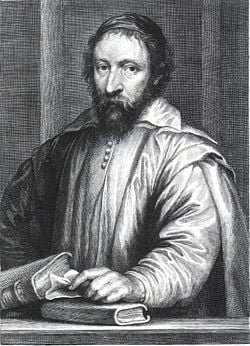Nicolas Claude Fabri de Peiresc
Nicolas-Claude Fabri de Peiresc (December 1, 1580 – June 24, 1637) was a French astronomer, antiquary and savant who maintained a wide correspondence with scientists and was a successful organizer of scientific inquiry, whose own researches were not confined to the matter of determining the difference in longitude of various locations in Europe, around the Mediterranean, and in North Africa. He was born at Belgentier, Var, France and grew up in the wealthy noble family of a higher magistrate in Provence. He was educated in Aix-en-Provence, Avignon, and at the Jesuit college at Tournon. At Toulon, he first became interested in astronomy. He undertook a longer travel in Italy, Switzerland and France in 1599, and finally finished his legal studies in 1604 in Montpellier. After receiving his degree, he returned to Aix and took over his uncle's position as conseiller in the Parlement of Provence, under the president of the Parlement, Guillaume du Vair. He and du Vair travelled to Paris 1605–1606 and in 1607–1615, he served at Aix.
In 1610, his patron, du Vair, purchased a telescope, which Peiresc and Joseph Gaultier used for observing the skies, including Jupiter's moons.
Peiresc discovered the Orion Nebula in 1610; Gaultier became the second person to see it in the telescope. However, this discovery fell forgotten until 1916 when G. Bigourdan announced its recovery.
From 1615–1622, Peiresc again made a trip to Paris with du Vair. Later, he returned to Provence to serve as senator of sovereign court. He became a patron of science and art, studied fossils, and hosted the astronomer Gassendi from 1634–1637. He had the Codex Luxemburgensis, the surviving Carolingian copy of the Chronography of 354 in his possession for many years; after his death it disappeared.
He died on June 24, 1637 in Aix-en-Provence.
Peiresc was honored by naming a lunar crater Peirescius (46.5S, 67.6E, 61 km diameter) in 1935.
External links
- de Peiresc biography and references Galileo Project at Rice University
- Life of the great Provençal humanist
- Project Peiresc by Prof RA Hatch
ReferencesISBN links support NWE through referral fees
- G. Bigourdan, 1916. "La decouverte de la nebuleuse d'Orion (N.G.C. 1976) par Peiresc" in Comptes Rendus, Vol. 162, p. 489-490
- Pierre Gassendi, The Mirrour Of True Nobility & Gentility Being The Life Of Peiresc, available online, in English
- Kenneth Glyn Jones, 1991. Messier's Nebulae and Star Clusters. 2nd ed, Cambridge University Press, p 337.
- Miller, Peter, Peiresc’s Europe
- Jane T. Tolbert, "Fabri De Peiresc's Quest For A Method To Calculate Terrestrial Longitude" in Historian, Summer, 1999 e-text
Credits
New World Encyclopedia writers and editors rewrote and completed the Wikipedia article in accordance with New World Encyclopedia standards. This article abides by terms of the Creative Commons CC-by-sa 3.0 License (CC-by-sa), which may be used and disseminated with proper attribution. Credit is due under the terms of this license that can reference both the New World Encyclopedia contributors and the selfless volunteer contributors of the Wikimedia Foundation. To cite this article click here for a list of acceptable citing formats.The history of earlier contributions by wikipedians is accessible to researchers here:
The history of this article since it was imported to New World Encyclopedia:
Note: Some restrictions may apply to use of individual images which are separately licensed.

